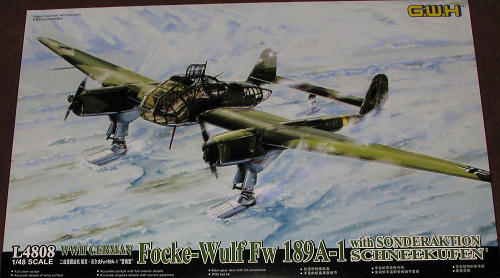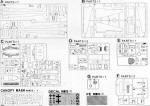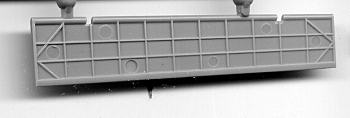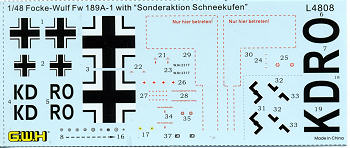
Great Wall Hobby 1/48 FW-189A-1 with Skis
| KIT #: | L4808 |
| PRICE: | $ |
| DECALS: | One option |
| REVIEWER: | Scott Van Aken |
| NOTES: |

| HISTORY |
In 1937, the Reichsluftfahrtministerium (RLM) issued a specification for a short-range, three-seat reconnaissance aircraft with a good all-round view to support the German army in the field, replacing the Henschel Hs 126, which had just entered service. A power of about 850-900 hp (630-670 kW) was specified. The specification was issued to Arado and Focke-Wulf. Arado's design, the Ar 198, which was initially the preferred option, was a relatively conventional single-engined high wing monoplane with a glazed gondola under the fuselage. Focke-Wulf's chief designer Kurt Tank design, the Focke-Wulf Fw 189 was a twin-boom design, powered by two Argus As 410 engines rather than the expected single engine and a central crew gondola, while Blohm & Voss proposed as a private venture something even more radical: chief designer Dr. Richard Vogt's unique asymmetric BV 141. Orders were placed for three prototypes each of the Arado and Focke-Wulf designs in April 1937.
Possibly the best reconnaissance aircraft to operate during World War II, the Fw 189 was produced in large numbers, at the Focke-Wulf factory in Bremen, at the Bordeaux-Merignac aircraft factory (now the Dassault Mirage plant) in occupied France, then in the Aero Vodochody aircraft factory in Prague, occupied Czechoslovakia. Total production was 864 aircraft of all variants.
Called the "Flying Eye" of the German army, the Fw 189 was used extensively on the Eastern Front with great success. Its Russian nickname was "Rama" (Frame), referring to its distinctive tailboom shape. Despite its slow speed and fragile looks, the Fw 189's maneuverability made it a difficult target for attacking Russian fighters. When attacked, the Fw 189 was often able to out-turn attacking fighters by simply flying in a tight circle into which enemy fighters could not follow. Its ruggedness was demonstrated when Fw 189s routinely returned to bases with one tail shot or torn off.
| THE KIT |
 Our
friends at GWH (previously Great Wall Hobby) have added another interesting
variant to their first, and very nicely done, aircraft kit the FW-189. There is little difference between
this and the previous kit aside from some minor things and I'll cover those when
the time comes. If you have seen or built any of their armor kits, then you are aware of the
quality of their kits. This one is no exception. Thankfully, there are not the
usual mass of rivets as you often see on other kits developed in China. I do
appreciate that. The kit comes on six sprues, one of which is clear and two of
which are identical. The clear bits are very well done and quite clear. This
time, Great Wall has placed them in a padded bag as my first kit suffered from
some broken clear bits (which Great Wall quickly replaced).
Our
friends at GWH (previously Great Wall Hobby) have added another interesting
variant to their first, and very nicely done, aircraft kit the FW-189. There is little difference between
this and the previous kit aside from some minor things and I'll cover those when
the time comes. If you have seen or built any of their armor kits, then you are aware of the
quality of their kits. This one is no exception. Thankfully, there are not the
usual mass of rivets as you often see on other kits developed in China. I do
appreciate that. The kit comes on six sprues, one of which is clear and two of
which are identical. The clear bits are very well done and quite clear. This
time, Great Wall has placed them in a padded bag as my first kit suffered from
some broken clear bits (which Great Wall quickly replaced).  ither
be easy to remove or will be difficult to see when the kit is complete. I should
also mention that the fabric flight control surfaces many have more 'hills and
valleys' than some will want, but to me it looked fine. The kit comes with a
photo etch fret that is used for seat harnesses, rudder pedals, upper flap
wells, engine wiring, tail
ither
be easy to remove or will be difficult to see when the kit is complete. I should
also mention that the fabric flight control surfaces many have more 'hills and
valleys' than some will want, but to me it looked fine. The kit comes with a
photo etch fret that is used for seat harnesses, rudder pedals, upper flap
wells, engine wiring, tail wheel door, gun sights, and a few other small pieces. Another real bonus is that
a full set of canopy masks is included. With all that 'glass', masking in the
normal way would be time consuming and tedious. Great Wall has not only given
wheel door, gun sights, and a few other small pieces. Another real bonus is that
a full set of canopy masks is included. With all that 'glass', masking in the
normal way would be time consuming and tedious. Great Wall has not only given
 us
the masks, but each one is numbered and the kit comes with a full placement
guide, making things almost easy.
us
the masks, but each one is numbered and the kit comes with a full placement
guide, making things almost easy.  The aircraft
as kitted comes from an unknown unit in the standard RLM 70/71/65 scheme with
yellow rear boom bands and outer lower wing tips. Just an omission on
my kit, but there was no overall color and markings guide, but an e-mail to GWH
had one sent to me via computer. The kit includes a full
color representation of the box art without the printing atop it. This is
provided in a protective plastic cover. The decal sheet is superbly printed and come with swastikas in
sections as well as stencils and wing walk areas.
The aircraft
as kitted comes from an unknown unit in the standard RLM 70/71/65 scheme with
yellow rear boom bands and outer lower wing tips. Just an omission on
my kit, but there was no overall color and markings guide, but an e-mail to GWH
had one sent to me via computer. The kit includes a full
color representation of the box art without the printing atop it. This is
provided in a protective plastic cover. The decal sheet is superbly printed and come with swastikas in
sections as well as stencils and wing walk areas. | CONCLUSIONS |
If you read the build review I did on their first release, you know what a great kit this Great Wall Hobby version really is. I'm pleased that they have continued with different variants and the ski equipped kit will make for something quite unusual on your display shelf.
| REFERENCES |
http://en.wikipedia.org/wiki/Fw_189
July 2012
My thanks to Great Wall Hobby for providing the preview kit. Visit
www.lionroar.net
for more on Great Wall kits. If you would like your product reviewed fairly and quickly, please
contact
me or see other details in the
Note to
Contributors.